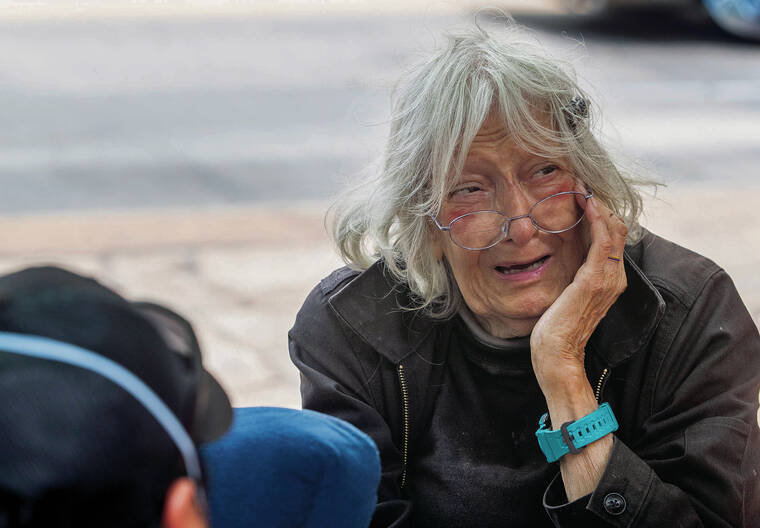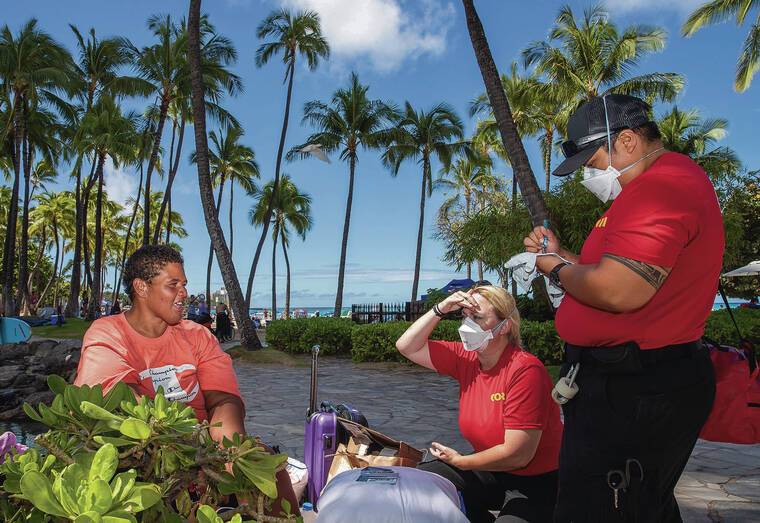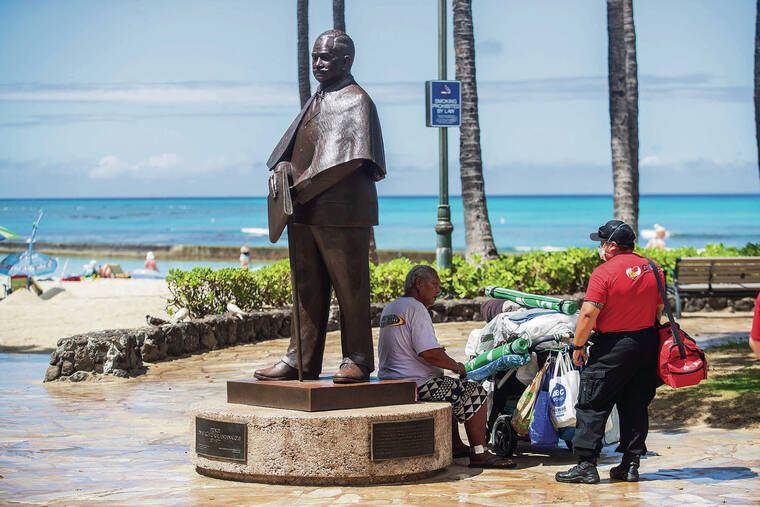Ann Taylor, 84, tears up when a team from the city’s Crisis Outreach Response and Engagement program finds her Thursday huddled under a bus stop awning in Waikiki — her home for the previous five days following an eviction from a nearby apartment.
Dr. Jim Ireland, director of the Honolulu Emergency Services Department, and CORE EMTs Molly Swanson and
Julianne Fajotina introduce themselves to Taylor and begin assessing her medical and housing needs. Given her age-related vulnerabilities, those needs are acute.
They tell Taylor they want to take her to the hospital where she can get medical treatment and connect to a hospital case worker to assist with housing. She agrees to go but only if CORE will come back for her husband, whom she said is battling cancer and was at a doctor’s appointment.
Joshua Lewis, a member of the Waikiki Business Improvement District’s Aloha Ambassadors hospitality program who connected CORE to Taylor, quickly agrees to help track down her husband upon his return.
Taylor appears apprehensive about the unknown but relieved to have found help. She said living at the bus stop in Kuhio Mini Park
No. 2, between Kapuni Street and Liliuokalani Avenue, has been an ordeal.
“It’s scary out here. There are people that live here who don’t want strangers here,” Taylor said. “Last night was really crazy. There were so many homeless people running around trying to take what you have. I already lost my ID. I’m a grown woman, I’m an intelligent woman. How did this happen? I’ve got no place to go.”
Taylor is just one of many unsheltered homeless residents that CORE is getting to know in Waikiki since it began prioritizing the district this month. This means teams are now proactively conducting outreach instead of just responding to problems.
“We have CORE teams coming (to Waikiki) three times a week this month, and by July we expect that they’ll be down here daily,” Ireland said.
THE PROGRAM, which started last fall in Chinatown, sends emergency medical technicians and community health workers to respond to community concerns and nonviolent, homeless-related 911 calls, and conducts outreach aimed at getting unsheltered homeless people housed.
CORE also relies on community health workers to help track clients and their outcomes. The more outreach and community support, the better the outcome, Ireland said.
Sometimes the process unfolds slowly. Ireland said on average, it takes about three outreach visits for CORE to build enough trust that a client will agree to accept help.
That was true of Delilah Makanani, a homeless woman CORE encountered Thursday only hours after she had been dropped off near the Waikiki police substation. A CORE team had previously met Makanani in Waipahu and just a little more than a week ago,
in Kalihi.
Makanani, who has been homeless on and off since 1984, tells the team she is receptive to housing. However, she doesn’t have an ID, and when they mention there might be space at the Institute for Human Services, she says she has not been vaccinated for COVID-19, which makes it more difficult to find her a shelter placement.
The team cannot address Makanani’s housing needs immediately so they note her doctor, case worker and other details that will help them follow up on subsequent visits.
“It’s like untangling a ball of yarn,” Swanson said.
Other times, as in Taylor’s case, the pace is swift.
“This is a situation we can’t accept; we won’t be leaving her here today,” Ireland said. “Out here she’s vulnerable to assault or being victimized. She doesn’t have adequate access to food or water. This is a must-save.”
CORE HAS limited resources, but they are expanding thanks to federal grants, which have increased the program’s annual budget to $2 million.
Ireland said CORE currently has a sport utility vehicle that operates from
8 a.m to 4 p.m. daily, and two ambulances, one that goes out from 9 a.m. to 5 p.m. daily and another that runs from 7 a.m. to 3 p.m. daily.
By August, one of those ambulances is expected to operate for 12 hours a day. By fall, Ireland expects to have at least one 24-hour CORE unit. He also plans to add one more ambulance this summer and another in the fall.
CORE’s push into Waikiki comes as a shift in homeless people from downtown to East Honolulu has contributed to a 71% increase in the district’s share of Oahu’s unsheltered population since 2019.
The 2022 Point-in-Time count, an annual one-night snapshot of the number of people experiencing homelessness who are on the street or in shelters, conducted March 10, showed that East Honolulu had experienced the highest percentage increase of unsheltered homeless of any district on Oahu.
The increase in homelessness in Waikiki has not escaped the residents who live and work in the district, the businesses that operate there or the visitors who are looking for paradise and finding it has fallen short.
Waikiki Neighborhood Board member Melissa Filek said the situation has grown untenable.
“There was a gal the other day carrying a mattress down Lemon Road,” Filek said. “One guy was out front on the corner of Lemon and Kapahulu, and he was wearing a trash bag on his bottom half and playing with himself.”
As a vacation rental owner, Filek said she’s also acutely aware of the negative impact of unsheltered homelessness and untreated mental illness on Waikiki’s businesses.
“I get complaints like, ‘Nice view of the five homeless guys parked in the zoo grassy area,’ or ‘The hotel is fine, but as soon as you walk outside it’s scary for the kids.’ A lot of my clientele are from the mainland East Coast,” she said, “so they are up super early and the whole of Waikiki just stinks like feces and urine. The city is out there every morning shooing them along, hosing the sidewalks.”
Jessica Lani Rich, president and CEO of the Visitor Aloha Society of Hawaii, said a mentally ill homeless woman attacked a 10-year-old visitor from California and her mother, who were waiting on Seaside Avenue for the bus to the Polynesian Cultural Center, at about 10:30 a.m. Tuesday. The child’s grandmother was also present but was not injured.
“The woman punched the girl in the face and pulled her hair and then assaulted her mother,” Rich said. “The victim was shouting for help and bystanders just stared. The mother said that is what hurt the most. She’s an officer with the Department of Homeland Security, and she was appalled by what happened.”
Rich worries that homelessness has become so prevalent in Waikiki that the community is getting complacent.
IRELAND SAID some of the recent rise in homelessness in East Honolulu might be related to efforts by CORE and the Chinatown/Kalihi Palama Weed and Seed program.
“Businesses have told us that we have reduced the unsheltered population by about 75% in Chinatown,” he said. “If you walk down Hotel or River Street now you’ll see one or two homeless people, but it’s not like it was a year ago where you would see 50.”
Ireland said some of the urban Honolulu crowd may have moved into other areas, which is not a win. But he said the program is designed to work holistically over time to get as many people as it can off the streets, which is always a complicated proposition.
“The thing that blew me away is that some folks we are finding have been homeless for longer than 10 years, which means that someone has been working with them and failing for essentially 10 years,” he said. “If we can house those people, it would be a huge win. We are asking the community to be patient — we are just getting started.”
So far CORE has serviced approximately 150 clients across the island, with about 90% coming from Waikiki and Chinatown, according to Ireland. The CORE crews see approximately 50 regular clients every week.
The program has helped get about 20 individuals get into some kind of shelter, he said.
Ireland said CORE could have housed more homeless individuals if there were more shelter space — a situation the city and its partners, including the state, are working on.
“We need 100 more shelter beds immediately,” he said. “We also need foster care and nursing home space for clients that have mental illness or dementia.”
Ireland said he suggested to Honolulu Mayor Rick Blangiardi and Lt. Gov. Josh Green that once the new Hawaii State Hospital opens in Kaneohe that the old facility could be repurposed as a mental health stabilization center.
In addition to helping homeless individuals find housing, CORE tries to divert unnecessary 911 calls, which lead to high costs and strained resources.
Ireland said the top nonemergency calls to EMS are made by people who say they ran out of their medicine, they are hungry or thirsty, or that they defecated in their pants.
“All three issues are legitimate needs, but they don’t need lights and sirens,” he said.
Every unnecessary ambulance ride costs about $1,800, Ireland said, while ER visits typically range from $1,000 to $3,000.
“Some patients call 911 every day,” he said. “CORE is focusing on that list as a high priority.”
Since CORE started, there has been an estimated drop of 20% to 30% in 911 calls in the downtown area, according to Ireland. CORE also is working on identifying and prioritizing service for frequent 911 callers.
EMS has roughly 10 people who call 911 for help more than 100 times a year, Ireland said, adding that the program already has shown results in dealing with them.








